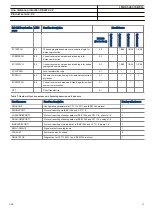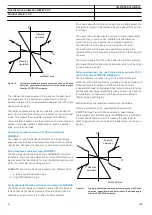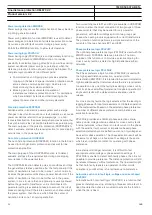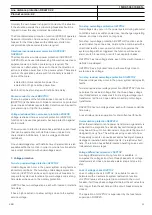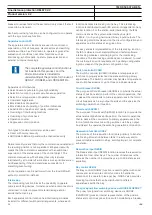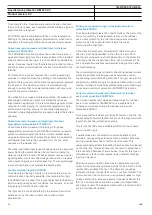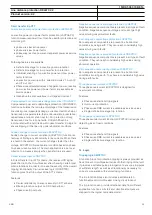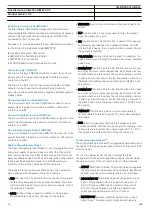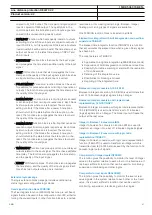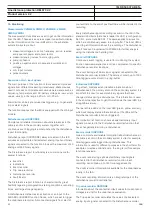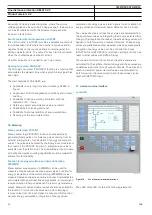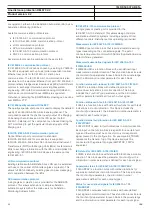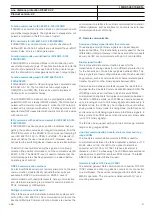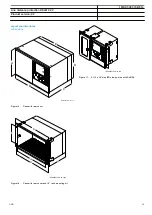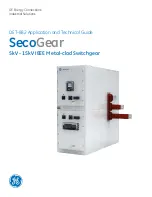
function block SMAI. However the main difference is that it can
be used to extract any frequency component from the input
signal. Thus it can, for example, be used to build sub-
synchronous resonance protection for synchronous generator.
11. Secondary system supervision
Current circuit supervision CCSSPVC
Open or short circuited current transformer cores can cause
unwanted operation of many protection functions such as
differential, earth-fault current and negative-sequence current
functions.
Current circuit supervision (CCSSPVC) compares the residual
current from a three phase set of current transformer cores with
the neutral point current on a separate input taken from another
set of cores on the current transformer.
A detection of a difference indicates a fault in the circuit and is
used as alarm or to block protection functions expected to give
inadvertent tripping.
Fuse failure supervision FUFSPVC
The aim of the fuse failure supervision function (FUFSPVC) is to
block voltage measuring functions at failures in the secondary
circuits between the voltage transformer and the IED in order to
avoid inadvertent operations that otherwise might occur.
The fuse failure supervision function basically has three different
detection methods, negative sequence and zero sequence
based detection and an additional delta voltage and delta
current detection.
The negative sequence detection algorithm is recommended
for IEDs used in isolated or high-impedance earthed networks.
It is based on the negative-sequence quantities.
The zero sequence detection is recommended for IEDs used in
directly or low impedance earthed networks. It is based on the
zero sequence measuring quantities.
The selection of different operation modes is possible by a
setting parameter in order to take into account the particular
earthing of the network.
A criterion based on delta current and delta voltage
measurements can be added to the fuse failure supervision
function in order to detect a three phase fuse failure, which in
practice is more associated with voltage transformer switching
during station operations.
Fuse failure supervision VDSPVC
Different protection functions within the protection IED
operates on the basis of measured voltage at the relay point.
Some example of protection functions are:
• Distance protection function.
• Undervoltage function.
• Energisation function and voltage check for the weak
infeed logic.
These functions can operate unintentionally, if a fault occurs in
the secondary circuits between voltage instrument
transformers and the IED. These unintentional operations can
be prevented by fuse failure supervision (VDSPVC).
VDSPVC is designed to detect fuse failures or faults in voltage
measurement circuit, based on phase wise comparison of
voltages of main and pilot fused circuits. VDSPVC blocking
output can be configured to block functions that need to be
blocked in case of faults in the voltage circuit.
12. Control
Synchrocheck, energizing check, and synchronizing SESRSYN
The Synchronizing function allows closing of asynchronous
networks at the correct moment including the breaker closing
time, which improves the network stability.
Synchrocheck, energizing check, and synchronizing
(SESRSYN) function checks that the voltages on both sides of
the circuit breaker are in synchronism, or with at least one side
dead to ensure that closing can be done safely.
SESRSYN function includes a built-in voltage selection scheme
for double bus and 1½ breaker or ring busbar arrangements.
Manual closing as well as automatic reclosing can be checked
by the function and can have different settings.
For systems, which can run asynchronously, a synchronizing
feature is also provided. The main purpose of the synchronizing
feature is to provide controlled closing of circuit breakers when
two asynchronous systems are in phase and can be connected.
The synchronizing feature evaluates voltage difference, phase
angle difference, slip frequency and frequency rate of change
before issuing a controlled closing of the circuit breaker.
Breaker closing time is a setting.
Autorecloser SMBRREC
The auto reclosing function provides:
• high-speed and/or delayed auto reclosing
• single and/or three phase auto reclosing
• support for single or multi-breaker applications.
The auto recloser can be used for delayed busbar restoration.
Up to five reclosing shots can be performed. The first shot can
be single-, two-, and /or three-phase depending on the type of
the fault and the selected auto reclosing mode.
Several auto reclosing functions can be provided for multi-
breaker arrangements. A priority circuit allows one circuit
1MRK 506 372-BEN -
Line distance protection REL670 2.2
Product version: 2.2
ABB
35
Содержание RELION REL670
Страница 1: ...RELION 670 SERIES Line distance protection REL670 Version 2 2 Product guide...
Страница 149: ...149...



